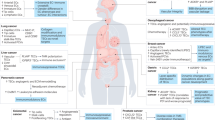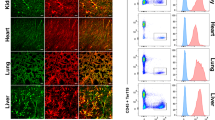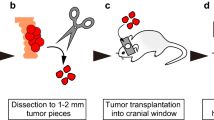Abstract
It has been shown that bone marrow–derived stem cells can form a major fraction of the tumor endothelium in mouse tumors. To determine the role of such cells in human tumor angiogenesis, we studied six individuals who developed cancers after bone marrow transplantation with donor cells derived from individuals of the opposite sex. By performing fluorescence in situ hybridization (FISH) with sex chromosome–specific probes in conjunction with fluorescent antibody staining, we found that such stem cells indeed contributed to tumor endothelium, but at low levels, averaging only 4.9% of the total. These results illustrate substantial differences between human tumors and many mouse models with respect to angiogenesis and have important implications for the translation of experimental antiangiogenic therapies to the clinic.
This is a preview of subscription content, access via your institution
Access options
Subscribe to this journal
Receive 12 print issues and online access
$209.00 per year
only $17.42 per issue
Buy this article
- Purchase on Springer Link
- Instant access to full article PDF
Prices may be subject to local taxes which are calculated during checkout

Similar content being viewed by others
References
Lyden, D. et al. Nat. Med. 7, 1194–1201 (2001).
Natori, T. et al. Biochem. Biophys. Res. Commun. 297, 1058–1061 (2002).
De Palma, M., Venneri, M.A. & Naldini, L. Hum. Gene Ther. 14, 1193–1206 (2003).
Hilbe, W. et al. J. Clin. Pathol. 57, 965–969 (2004).
Schlegelberger, Y.Z. a. B. in Methods in Molecular Biology (ed. Fan, Y.-S.) 379–390 (Humana Press, 2003).
Man, Y.G. & Burgar, A. Pathol. Res. Pract. 199, 815–825 (2003).
Wang, X. et al. Nature 422, 897–901 (2003).
Alvarez-Dolado, M. et al. Nature 425, 968–973 (2003).
Lin, Y., Weisdorf, D.J., Solovey, A. & Hebbel, R.P. J. Clin. Invest. 105, 71–77 (2000).
Davidoff, A.M. et al. Clin. Cancer Res. 7, 2870–2879 (2001).
Reyes, M. et al. J. Clin. Invest. 109, 337–346 (2002).
Stoll, B.R., Migliorini, C., Kadambi, A., Munn, L.L. & Jain, R.K. Blood 102, 2555–2561 (2003).
Sikder, H. et al. Cancer Cell 4, 291–299 (2003).
Ruzinova, M.B. et al. Cancer Cell 4, 277–289 (2003).
Jiang, S. et al. Proc. Natl. Acad. Sci. USA 101, 16891–16896 (2004).
Acknowledgements
We thank L. Brennan and C. Roberts (Dana-Farber Cancer Institute, Boston, Massachusetts) for help with obtaining clinical samples. We would also like to thank B. Schlegelberger (MH Hannover, Germany) and S. Popp (DKFZ Heidelberg, Germany) who provided helpful technical advice for combined IF-FISH, T.S. Bruce, and G. Parmigiani for his advice on statistical issues. This work was supported by National Institutes of Health grant CA57345.
Author information
Authors and Affiliations
Corresponding author
Ethics declarations
Competing interests
The authors declare no competing financial interests.
Supplementary information
Supplementary Fig. 1
Blood vessel from a female control sample of a submandibular mucoepidermoid carcinoma analyzed by FISH with a X-chromosome specific probe in conjunction with fluorescent antibody staining (PDF 34 kb)
Supplementary Table 1
Patients who developed cancers following bone marrow transplantation with donors of the opposite sex (PDF 11 kb)
Supplementary Table 2
Internal controls (PDF 11 kb)
Supplementary Table 3
Chimerism analysis of transplant patient samples (PDF 10 kb)
Rights and permissions
About this article
Cite this article
Peters, B., Diaz, L., Polyak, K. et al. Contribution of bone marrow–derived endothelial cells to human tumor vasculature. Nat Med 11, 261–262 (2005). https://doi.org/10.1038/nm1200
Received:
Accepted:
Published:
Issue Date:
DOI: https://doi.org/10.1038/nm1200
This article is cited by
-
CXCL13/CXCR5 axis facilitates endothelial progenitor cell homing and angiogenesis during rheumatoid arthritis progression
Cell Death & Disease (2021)
-
Impact of mesenchymal stem cells’ secretome on glioblastoma pathophysiology
Journal of Translational Medicine (2017)



